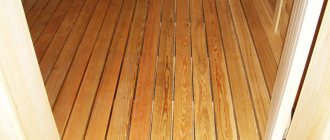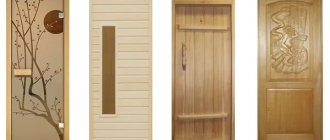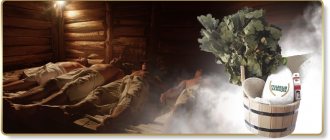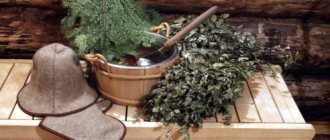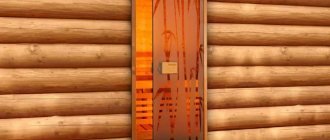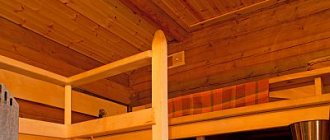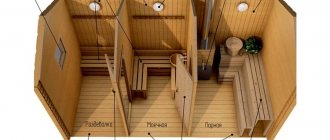Interior decoration creates coziness and a pleasant atmosphere in the room. Wood is considered a practical and environmentally friendly type of finishing materials for a bath. Due to the fact that the room is exposed to high temperatures and humidity, not all types of wood are suitable for interior decoration. The sauna board is made from varieties of wood that are resistant to temperature changes.
Choice of finishing material
Traditionally, wood is used to cover the steam room, which gives the room a beautiful appearance, creates a healthy atmosphere and retains heat. However, there are many different types of wood and of course the question arises, what kind of wood is best to cover a steam room?
Various types of wood are used to produce bath finishing materials. However, it is not recommended to use coniferous wood to cover the steam room, since it can release resin when heated strongly (read: “Finishing a steam room in a bathhouse with your own hands - from floor to ceiling”). It is best to use such types of wood for finishing a bath as linden, larch, oak, and aspen. If you really want to enjoy the pine aroma during bath procedures, then you can finish it with cedar material. It is durable and not resinous.
Is it possible to use a terrace board in a bathhouse?
Terrace board is a popular material used for interior decoration of baths. It is manufactured for use in the fresh air and in conditions of high humidity. Additional treatment with resins increases resistance to the formation of mold, fungi, and bacterial development.
The decking board has a corrugated surface. Parallel furrows allow you to effectively organize a drainage system. It will not allow moisture to destroy the structure of the floor. The floor, made of terrace boards, is non-slip. If installed correctly, it looks beautiful and expensive.
Requirements for the material for covering the steam room
When choosing what to cover a steam room in a bathhouse with, you should pay attention to such points as:
- The wood must be moisture-resistant and dry quickly, which will allow it to avoid rotting.
- The resin content should approach zero. The best option is to have no resins at all.
- The surface must be flat, smooth, free from roughness, gaps and knots.
- Wood should have low thermal conductivity, since wood that is highly heated in a steam room can burn the skin.
When choosing which is the best tree to buy for a steam room, you should pay attention to linden. Lining made from such wood is considered the most optimal material. First, find out which lining is best for a sauna, only then start planning construction. Linden wood has low thermal conductivity, is easy to process, and releases beneficial essential oils.
Aspen is also a good material for a steam room, as it is durable, strong and has healing properties. And another advantage is its low cost.
When deciding what kind of wood to cover the inside of the bathhouse with, you can opt for larch. It has a positive effect on the human body, has high density, strength, low thermal conductivity, and does not absorb moisture. In general, such wood has all the necessary qualities and is perfect for finishing a bathhouse.
Application and installation
Manufacturers of decking boards provide customers with instructions for installing and operating their products. It is recommended that you read the document before starting installation work. Laying technology may differ from similar material from another manufacturer.
Installation of boards begins with the preparation of the supporting structure. It consists of crossbars laid in one plane. The crossbars are fixed at a distance of 30–40 cm. This distance allows you to create reliable support for the flooring.
The structure is laid on the bottom frame and fixed with nails measuring 100 - 120 mm. In places where there are large spans, additional support from blocks is installed.
After installing the supporting structure, you can begin laying the wood. The boards are attached to the joists at the same distance from each other to form a free joint. Installation occurs in a certain sequence.
- Wooden parts are adjusted according to the size of the room.
- The first board is laid with a gap of 5 mm from the wall.
- On the back side of the board, at an angle of 45 degrees, fasteners are installed (hammered in and bent towards the panel).
- The second bar is installed. It is placed parallel to the previous board. The gap between the parts remains 5 mm.
- Subsequent boards are mounted in the same way.
When installing a board in a dressing room, corridor, or rest room, it is permissible to use solid flooring.
To understand the technology of installing decking boards, it is worth remembering the common mistakes of builders:
- non-compliance with the dimensions of the gap between the boards;
- the logs are fixed at too great a distance;
- The board is laid tightly against the wall.
These shortcomings worsen the quality of work and performance properties of the material.
The technology of laying decking boards requires knowledge and skills. Beginners are advised to familiarize themselves with the installation technology before starting construction work. This will help avoid mistakes during work.
Attention! When decorating a bathhouse, you should remember that materials such as paint, stain, and varnish cannot be used in the steam room. When heated, they release toxins. Inhalation of toxic fumes leads to poisoning.
Interior arrangement of the steam room
As a rule, benches, shelves, and headrests are installed in the steam room. They are fairly easy to make, so you can do it yourself. It is recommended to make bath furniture from the same type of wood that was used to cover the walls of the steam room.
Nowadays African oak, or abashi in other words, has become widespread.
It has such advantages as:
- low thermal conductivity;
- moisture resistance;
- high density;
- durability;
- strength;
- does not deform;
- pleasant to the touch.
The disadvantage of abashi is its rather high price.
Pine paneling
The lining made from this wood has a beige color, which looks quite stylish. But over time, the material, unfortunately, darkens, this must be taken into account when choosing. If you examine the pine paneling in detail, you will notice pine tree rings and visible droplets of resin on it.
If you heat the pine panels, even more resin will come out, and it will also be hot. For this reason, it is undesirable to carry out interior finishing in a steam room, because there a person can accidentally touch a place with leaked resin and get burned.
It is also not recommended to finish the ceiling in this room; the resin will flow down.
A dressing room and a washroom are suitable for finishing with pine clapboard. This finishing material has the following advantages:
- Its cost is much lower compared to materials from other tree species.
- Pine itself is quite resistant to moisture, but often this property is further enhanced by applying a protective coating.
- Pine lining attracts the eye with its texture and color.
- When heated, pine releases a pleasant aroma, which has a beneficial effect on human health.
Recommendations for finishing the steam room
When covering a steam room, the lining can be mounted vertically or horizontally (for more details: “How to mount lining in a bathhouse - rules and installation sequence”). If a horizontal arrangement is chosen, then the lining should be nailed from the bottom up. This technique will prevent water from seeping into the joints.
First you need to install vertical posts, between which the insulation material will be laid. To do this, markings are made, which should start from the corner. The distance between the inner sides of the racks should be 59 cm. This step will allow you to correctly install the insulation of the required thickness.
There are some peculiarities when cladding the walls of a log bathhouse. Fastening the sheathing boards in a vertical position is quite difficult, and not everyone decides to do this work themselves. To obtain the desired result and avoid mistakes, it is necessary to process the side of the vertically located racks facing the logs.
Subtleties of design
The simplicity of construction and its accessibility for non-professionals does not mean that you can safely start work without preparation. Even having experience in such work does not give grounds for a complacent attitude. A well-thought-out design and drawings of the future structure will help you avoid serious mistakes.
The simplest scheme is when the steam room, shower, boiler room and dressing room are combined. But such a step is acceptable only for mini-structures or transportable bathhouses, because it is not possible to distribute the temperature as expected. Therefore, they try to create, even with the smallest dimensions, even very small, but autonomous rooms. A 3x4 m bath can easily be heated by a small boiler or a wood-fired stove. Some designers even find the opportunity to supplement it with a veranda or terrace.
Minimum-sized projects have a number of valuable properties:
- low consumption of building materials;
- almost complete elimination of waste;
- high speed of work;
- strength and reliability (since in a small area there is no need to save on the quality of components).
On a larger site, it is quite possible to build a 6x6 bathhouse: it will allow you not only to wash off the dirt from yourself, but also to invite the whole family and even a group of friends. Typical projects with such sides involve a significant area of the rest room - it can reach 20 m2. Most often, this is where the staircase connecting the first floor with the attic is located.
A two-story bathhouse is superior to a one-story bathhouse simply because it allows you to organize additional space for living and leisure. Often there are rooms for receiving guests, bedrooms, billiard tables or other sports equipment.
In the construction of two floors, the first step is to create a foundation from support pillars, and the base must be covered with a layer of waterproofing. Experts recommend building a truss system for a bathhouse from boards with a cross-section of 10x5 cm, and the lathing usually uses a board 2.2 cm thick.
The frame-panel structure is assembled according to the principle of a toy construction set. It is not difficult to find combinations of elements suitable for the construction of a washing room with a swimming pool; then they are simply placed on the prepared frame. The kit usually comes with detailed technological instructions that help to avoid mistakes - as long as they are strictly followed. In the case of mobile bathhouses, everything is even simpler - they are assembled not at construction sites, but at industrial enterprises. All that remains for customers is to supplement the finished blocks with the necessary parts.
Most projects involve the use of gable roofs; the attic space under them is not organized or it is very small. Bath equipment is often placed inside. When choosing the type of foundation, they are guided by the category of soil and its condition. The mass of the building, even if we take into account the presence of a second floor in a number of options, is relatively small. Design insulation indicators depend on whether the bathhouse will be used year-round or whether it is intended only for the warm season.
Nuances of the interior decoration of the steam room
Naturally, before starting this stage, you need to already know how to line the inside of the bathhouse, as well as purchase all the necessary materials. The most used and recommended method of fastening the lining is flush fastening.
Before you begin finishing work, you need to prepare the material that will be used to finish the steam room. Before attaching it to the walls, the lining must undergo acclimatization in the room in which it will be used.
The floor in the steam room must be higher than the floor level in other rooms. The shelves are installed above the heater by about 10 cm. Benches and shelves should not have sharp corners. Only natural materials should be used inside the steam room.
It is very important to choose what kind of wood to cover the steam room with, since not all types of wood are suitable for this. You should also take into account all the finishing features of the most important room of the bathhouse, which determines whether the procedures taken will be useful.
